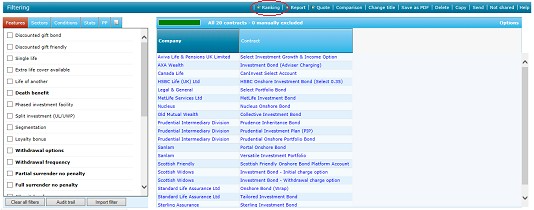Once you have researched a list of contracts they can be ranked into a league table. You simply click on the Ranking tool in the menu bar at the top of the filtering screen, as illustrated by the screenshot below.

(N.B. Ranking isn’t compulsory. You can go straight from the filtering stage to generating a suitability report by using the Report tool on the menu bar of the filtering page.)
The ranking page is illustrated by the second screenshot, and consists of two panes:

- The left-hand box lists all the categories of criteria on which you can rank the contracts – e.g. financial strength, past performance, desirability.
- The right-hand box lists all the items in the currently selected category.
Individual items, and the categories which contain them, are highlighted in green when you make a selection.
You can choose any number of items to rank on, and each item you are interested in can be marked as Low, Medium or High importance. You simply leave blank any items which you don’t want to rank on.
When you have finished building your ranking scheme you click on the Calculate button (or the Calculate link in the menu bar).
Categories of ranking item
The categories of ranking item which are available depend on the type of contract. The most common ones are as follows:
- Desirable features. This lets you mark features which you would like contracts to have in order to meet client requirements, but where the lack of that feature is not serious enough to warrant exclusion of the contract from the list. (If a feature is absolutely essential, then you should filter on it in the previous stage so that contracts are eliminated if they don’t offer it.)
- Financial strength. Allows ranking of contracts based on the financial strength rating of each provider, as assessed by AKG or Moody’s.
- Fund link stats. Allows ranking of contracts on the number of fund links they provide, and the number of sectors in which they have a fund link.
The list of categories will also include entries for premium rates (on rate-driven products), or projected figures such as surrender values (for investment-based contracts, allowing them to be ranked based on their total charging structure).
Note – for some contracts, Synaptic offers a Live Quote facility, which retrieves accurate premiums (and other information, such assums assured) as part of the research. The premiums can then be used as ranking criteria. For more details, see the live quotes section.
N.B. In the filtering stage it’s possible to eliminate contracts based on specific charges such as exit charges and allocation rates.However, unless you are dealing with a very specific scenario, this filtering on individual fields may not accurately reflect each contract’s total charging structure. For recommendations to clients, it is more reliable to rank on fields which take all charges into account than to filter based on specific charges.
Ranking on past performance
The list of categories also includes an entry for past performance calculations in each sector which you have filtered on. Therefore, you can only rank on past performance if you filter the list of contracts on at least one sector.
The system shows a separate group of ranking items within each sector, rather than treating past performance across all sectors as a single ranking item. This is in order to cater for the following type of scenario:
- An adviser has the policy of rotating clients’ money between a number of areas such as the UK, the US, Europe, property, and cash. At any given point in the economic cycle the adviser will be investing clients’ money in, say, three of these five sectors.
- In the filtering stage the adviser therefore selects all five sectors, removing any contracts which do not offer at least one fund in each sector. This ensures that the remaining contracts are capable of fulfilling the adviser’s investment policy both now and in the future.
- However, the adviser may only want to rank on the sectors in which he/she plans to invest the client’s money right now. If the adviser is going to recommend investment in the UK and US only (with the expectation that money will e.g. be rotated into Europe and cash next year) then they filter on all five sectors, but only choose to rank on past performance in the UK and US.
- Therefore, the system presents each sector as a separate group of past performance figures, in order to accommodate the above scenario.
The list of ranking items within a sector is as follows (andthis full list is only available for customers who have paid for the premiumedition of Synaptic Research).
- Past performance over 6 and 9 months, plus 1, 2, 3, 4, 5, 6, 7, 8, 9 and 10 years.
- Volatility (over 3 years).
- Alpha (over 3 years, compared to the sector average).
- FE Crown ratings.
- Quartile consistency.
All these items are defined below. If a contract has more than one fund in a sector then the system uses the best one (over the specified time period) in order to calculate the ranking score for the contract.
